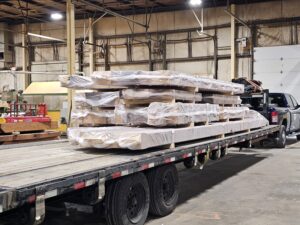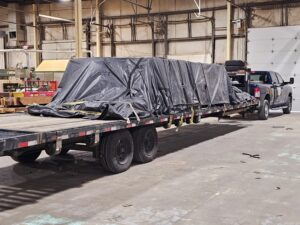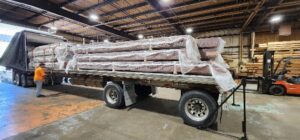Proper Bunking and Shipping of Timbers: Protecting Your Investment from Yard to Jobsite
Timber framing starts long before the first post is set on the foundation. The journey of your timbers—from the mill to your building site—can make the difference between perfectly straight, defect-free members and a frustrating, costly rework.
One of the most overlooked but critical steps in this journey that Timbercraft incorporates into our manufacturing process is proper bunking and shipping.
Why Bunking Matters
Bunking is the process of stacking timbers in uniform, supported layers for storage and transport. Done right, it:
-
Prevents warping and twisting during storage or transit.
-
Protects surfaces from dents, gouges, and dirt.
-
Makes loading and unloading safer for crews and equipment.
A poorly bunked timber load can shift during transport, create dangerous unloading situations, and even arrive damaged—costing time and money to replace. Which is why Timbercraft makes it a priority to bunk and load the precautions.
Best Practices for Bunking Timbers

1. Use Level, Solid Ground
Bunk stacks should rest on a level, compacted surface or on dunnage (spacers) to keep them elevated and away from moisture. Uneven ground can stress the timbers and cause bending over time. Timbercraft uses ample dunnage and all timbers are never set down without proper spacing.
2. Uniform Spacing of Dunnage
Place dunnage (often 4×4s or 6×6s) evenly along the length of the stack—typically every 4 to 6 feet for most lengths.
All dunnage should be directly in line vertically so the weight is evenly supported.
3. Keep Timbers Off the Ground
Even treated wood will absorb moisture if it sits directly on soil or concrete. Always elevate the first layer to allow airflow underneath.
4. Protect the Faces

If the timbers are planed, sanded, or pre-finished, add slip sheets, cardboard, or felt paper between layers to prevent abrasion. With shipping, Timbercraft loads with even bunks, spaced properly with dunnage, protected with cardboard and always covered. We want to ensure that upon arrival the timbers look just as good as when they left our shop.
5. Stack by Size and Length
Keep similar dimensions together to avoid uneven pressure points. The heaviest and largest members should go on the bottom.
Preparing Timbers for Shipping
1. Bundle Securely
Use heavy-duty steel or polyester strapping to keep stacks tight. Too loose, and pieces can shift; too tight, and you may damage edges.
2. Cover—But Let Them Breathe
A breathable tarp or shrink wrap keeps dirt and weather off without trapping condensation. Never fully seal green timbers in plastic.
3. Mark Clearly
Label each bundle with its destination, contents, and any handling instructions. This helps the install crew when receiving shipments. At Timbercraft, we number all bunks with each timber also being labeled. We supply prints that show where each timber fits into the puzzle and what bunk each of those timbers are on. We really try to make it an RTI (ready to install) product.
4. Load for Stability
On flatbeds, arrange the heaviest bundles on the bottom and over the axles. Use proper blocking and tie-downs to prevent shifting during transport.
The Bottom Line
Proper bunking and shipping isn’t just a matter of convenience—it’s about us protecting the quality and value of your timbers.
A few extra minutes of care in the yard and during loading can save hours of frustration (and hundreds of dollars) once on the jobsite.
Our timbers are the backbone of your project—Timbercraft treats them accordingly, from the first cut to the final delivery. We want to make sure the transitions are flawless. 
